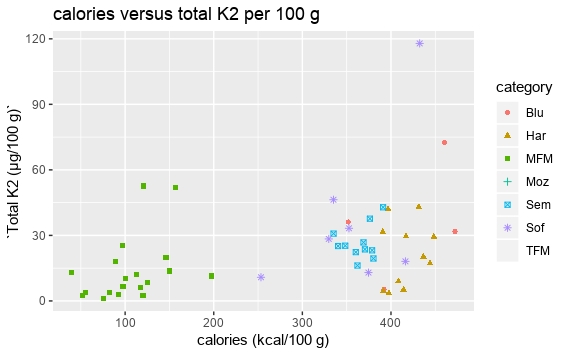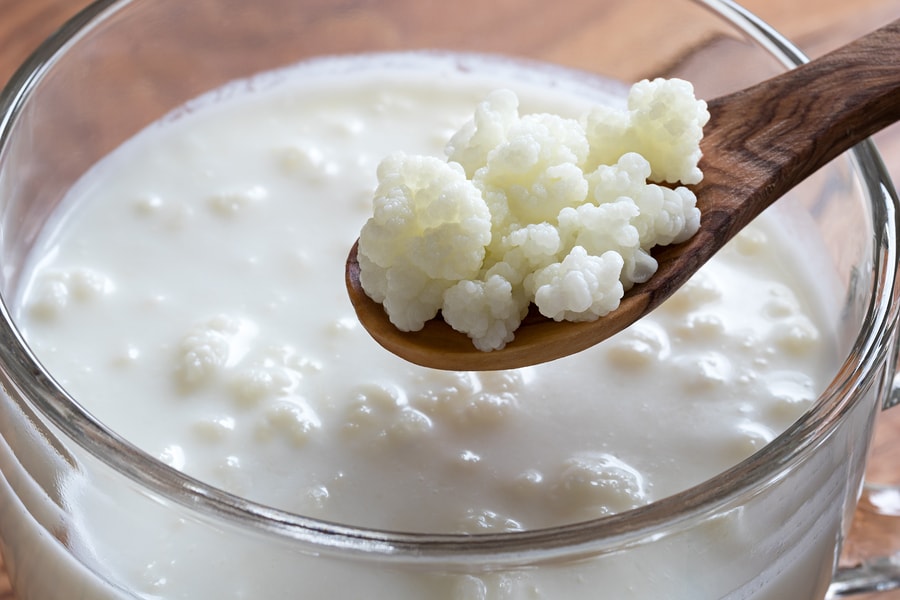How much vitamin K2 is there in Kefir?
Is there vitamin K2 in kefir? We will start with Chris Kresser's blog where he published a good general introduction about the benefits of kefir[1]. He mentions it is rich in vitamin K2 but when you check out the reference provided[2], there's no mention anywhere in that article of vitamin K , K2 or menaquinones. Further down in Kresser's blog comments, a few of his blog readers are also wondering if there is actually any K2.
So first, let's visit the ultimate resource for vitamin K2 and its searchable database[3], thanks to the colossal efforts of Dr Chris Masterjohn.
Unfortunately, there is no kefir directly listed in this database but we can still get an idea when you search under "mesophilic fermented milk".
Kefir is a mesophilic fermented milk
Mesophilic bacteria can ferment their substrate, milk in this case, at room temperature. As opposed to thermophilic bacteria that require higher temperatures to ferment, for example, lactobacillus bulgaricus to produce yogurt.
Masterjohn's K2 database[4] reports an average of 13.4 μg of vitamin K2 for 100g of fermented milk based on that study:
Manoury E, Jourdon K, Boyaval P, Fourcassi̩ P. Quantitative measurement of vitamin K2 (menaquinones) in various fermented dairy products using a reliable high-performance liquid chromatography method. Journal Dairy Science. 2013 Mar;96(3):1335-46.[5]
But that study is using 21 different sorts of fermented milks, so we might be able to get more details. Let's dig in...
In that article, MFM16 and MFM17 are explicitly identified as polish twaróg (quark)[6]. These 2 MFM are the highest in vitamin K2, at 52 µg / 100 g, beating most semi and hard cheeses, for a quarter of the calories.
What about the other 19 MFM in that article? Can we find kefir in there?
We can get some physicochemical characteristics such as DM (Dry Matter), Fat and pH from table 1 of Cetinkaya and Mus 2012[7] based on 51 turkish samples:
| Parameter | Mean ± SEM | Minimum | Maximum |
|---|---|---|---|
| pH | 4.3 ± 0.02 | 3.9 | 4.7 |
| Dry matter, % | 11.3 ± 0.36 | 8.0 | 16.5 |
| Fat, % | 2.3 ± 0.14 | 0.3 | 4.5 |
Filtering down all MFM from Manoury2013[5] to match these kefir properties, we find 3 MFM candidates:
| category and ID | MFM12 | MFM14 | MFM15 |
|---|---|---|---|
| Country | Poland | Poland | Poland |
| Shelf.life.date (month/day/year) | 11/26/2010 | 12/10/2010 | 12/05/2010 |
| Analysis.date (month/day/year) | 11/26/2010 | 12/10/2010 | 12/03/2010 |
| DM (g/100 g) | 9.3 | 11.9 | 11.3 |
| Fat (g/100 g) | 0.5 | 1.5 | 1.3 |
| pH | 4.40 | 4.52 | 4.24 |
| MK-6 | ND | ND | ND |
| MK-7 | 4.3 ± 0.4 | ND | ND |
| MK-8 | 17.4 ± 0.3 | 7.1 ± 0.8 | 4.4 ± 0.5 |
| MK-9 | 98.1 ± 1.5 | 31.1 ± 0.7 | 19.3 ± 1.7 |
| MK-10 | 9.9 ± 0.8 | ND | ND |
| Total K2 (ng/g) | 129.7 ± 1.9 | 38.2 ± 1.4 | 23.7 ± 2.0 |
| calories | 39.7 | 55.1 | 51.7 |
| Total K2 (µg/100 g) | 12.97 | 3.82 | 2.37 |
But that does not give us a definitive answer. We do not know if MFM12, 14 and 15 are really kefir.
Hopefully, I stumbled upon this article: Multiple Vitamin K Forms Exist in Dairy Foods Current Developments in Nutrition, Volume 1, Issue 6, 1 June 2017, e000638 [8]
Straight from that article: "Low-fat kefir (n = 4) contained 10.2 ± 0.3 µg total vitamin K/100 g, of which only MK9 and MK11 were detected."
And this more recent article "Determination of Vitamin K Composition of Fermented Food.” Food Chemistry 275 (March 1, 2019): 515–22. [9] in Table 2:
Kefir (fermented bovine milk, Finnish): MK-8 3.90 ± 2.23 µg/100 g and MK-9 4.50 ± 2.38 µg/100 g
Both articles report values within the range of the estimate of 2 to 13 µg/100 g, that I pointed out in the previous table.
What about calories?
Now, let's take things further. We can estimate the amount of calories based on the dry matter and fat mass from Table 3 in Manoury2013[5]. From there, we can plot this new graph showing how many calories and how much vitamin K2 each product has. We have 2 clear clusters: MFM averaging 106 kcal/100 g and all the others averaging 353 kcal/100 g

Another thing worth pointing out is that kefir and mesophilic fermented drinks beat down in price/volume and availability most other sources of vitamin K2. You do not need to invest in expensive equipments, it brews at room temperature and it is usually ready after 24 hours of fermentation.
One liter of kefir costs you the price of one liter of milk, that's 1 to 2 €. The time and money invested to get the kefir grains is recovered just after a few days of use. You are only limited by your local supply of milk, widely available across all western countries. Natto or specific cheeses may be more difficult to get hold of and they will be more expensive for an equivalent amount.
Conclusion
Mesophilic fermented milks, such as twaróg and kefir, are a low cost and low calorie addition to include vitamin K2 in your diet but you should not rely on that drink as your sole source for that group of vitamins.
Appendix
If you would like to reproduce the tables and graphs I posted here, you can run the code below in R. I also attach a csv of the data if you prefer to test that in libre office or excel.
library(tabulizer) library(magrittr) library(ggplot2) # https://doi.org/10.3168/jds.2012-5494 u <- 'http://www.healthycheeselady.com/wp-content/uploads/2017/11/Manoury2013.pdf' # or if you already have a local copy # u <- 'Manoury2013.pdf' # physicochemical properties table t1 <- extract_tables(u, pages = 2, output = "data.frame")[[1]] t1b <- extract_tables(u, pages = 3, output = "data.frame")[[1]] # the first row is not data, it belongs in the header t1b <- t1b[-1,] # put table 1. back together, it was split between page 2 and 3 of the article t1 <- rbind(t1,t1b) # we need to merge the first 2 rows to get the table header row as it was divided when parsing the pdf names(t1) <- paste(names(t1),t1[1,]) names(t1)[7] <- 'pH' names(t1)[1] <- 'category and ID' #remove the first row, already merged in the table header t1 <- t1[-1,] #we want physicochemical properties as numeric values t1[,5] <- as.numeric(t1[,5]) t1[,6] <- as.numeric(t1[,6]) t1[,7] <- as.numeric(t1[,7]) # menaquinones content table t5 <- extract_tables(u, pages = 6, output = "data.frame")[[1]] t5b <- extract_tables(u, pages = 7, output = "data.frame")[[1]] t5b <- t5b[-1,] t5 <- rbind(t5,t5b) names(t5) <- t5[1,] t5 <- t5[-1,] m <- merge(t1,t5) m <- na.omit(m) # extract total K2 as numerical values and convert ng/g to µ/100g m$`Total K2 (µg/100 g)` <- gsub(' ±.*','',m$`Total K2`) %>% gsub(',','',.) %>% as.numeric()/10 # calculate calories / 100g # we get 9 calories / g of fat and 4 calories for protein or carbohydrates (approximated to be the remaining dry matter) m$calories <- 9 * m$`Fat (g/100 g)` + 4 * (m$`DM (g/100 g)` - m$`Fat (g/100 g)`) # extract category for group plotting by category later on m$category <- as.character(m$`category and ID`) %>% substr(.,1,3) %>% as.factor() # how many calories do you need to consume to reach adult RDA of 75 µg for total K2 m$'calories to reach 75 µg K2' <- as.integer(m$calories * 75/m$`Total K2 (µg/100 g)`) # how much K2 in 100 kcalories m$`K2 in 100 kcal (µg)` <- m$`Total K2 (µg/100 g)` * 100 / m$calories# extract the subset of fermented milks that could match milk kefir physicochemical properties # filter values based on table 4 in https://www.researchgate.net/publication/266503329_Determination_of_microbiological_and_chemical_characteristics_of_kefir_consumed_in_Bursa kefir <- subset(m, m$category == "MFM" & m$`DM (g/100 g)` > 7.9 & m$`DM (g/100 g)` < 16.6 & m$`Fat (g/100 g)` > 0.3 & m$`Fat (g/100 g)` < 4.6) t(kefir) ggplot(m, aes(calories,`Total K2 (µg/100 g)`, shape = category, color = category)) + geom_point() + ggtitle('calories versus total K2 per 100 g') + xlab('calories (kcal/100 g)') write.csv(m, file = 'fermented.milks.csv',row.names = FALSE)
References
[1] ^ Chris Kresser. “Kefir: The Not-Quite-Paleo Superfood.” (blog), March 2, 2012. https://chriskresser.com/kefir-the-not-quite-paleo-superfood/
[2] ^ Semih Otles and Ozlem Cagindi , 2003. Kefir: A Probiotic Dairy-Composition, Nutritional and Therapeutic Aspects. Pakistan Journal of Nutrition, 2: 54-59. https://doi.org/10.3923/pjn.2003.54.59
[3] ^ Chris Masterjohn. "The Ultimate Vitamin K2 Resource" (blog), September 9, 2016. https://chrismasterjohnphd.com/2016/12/09/the-ultimate-vitamin-k2-resource/#database
[4] ^ https://chrismasterjohnphd.com/advanced-results-mk-4/entry/5917/
[5] ^ ^ ^ E. Manoury, K. Jourdon, P. Boyaval, and P. Fourcassié. “Quantitative Measurement of Vitamin K2 (Menaquinones) in Various Fermented Dairy Products Using a Reliable High-Performance Liquid Chromatography Method.” Journal of Dairy Science 96, no. 3 (March 1, 2013): 1335–46. https://doi.org/10.3168/jds.2012-5494
[6] ^ https://en.wikipedia.org/wiki/Quark_(dairy_product)
[7] ^ Figen Cetinkaya and Tulay Elal Mus. “Determination of Microbiological and Chemical Characteristics of Kefir Consumed in Bursa.” ResearchGate. https://www.researchgate.net/publication/266503329_Determination_of_microbiological_and_chemical_characteristics_of_kefir_consumed_in_Bursa
[8] ^ Xueyan Fu, Stephanie G. Harshman, Xiaohua Shen, David B. Haytowitz, J. Philip Karl, Benjamin E. Wolfe, and Sarah L. Booth. “Multiple Vitamin K Forms Exist in Dairy Foods.” Current Developments in Nutrition 1, no. 6 (June 1, 2017). https://doi.org/10.3945/cdn.117.000638
[9] ^ Marko Tarvainen, Mikael Fabritius, and Baoru Yang. “Determination of Vitamin K Composition of Fermented Food.” Food Chemistry 275 (March 1, 2019): 515–22. https://doi.org/10.1016/j.foodchem.2018.09.136
https://en.wikipedia.org/wiki/Fermented_milk_products
Additional references for vitamin K2 content in fermented foods:
Matthew Dalby. “The Menaquinone (Vitamin K2) Content of Animal Products and Fermented Foods.” The Call of the Honeyguide (blog), March 10, 2014. https://honey-guide.com/2014/03/10/menaquinones-k2-and-phylloquinone-k1-content-of-animal-products-and-fermented-foods/


Comments (0)
Add new comment